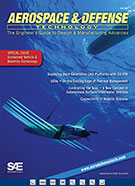Standard
Lighting Applications for Unmanned Aircraft Systems (UAS)
2019-12-05
CURRENT
ARP6336
This SAE Aerospace Recommended Practice (ARP) provides technical recommendations for the lighting applications for Unmanned Aircraft Systems (UAS). The technical content of this ARP discusses the unique trade-offs that are necessary to maintain commonality to the U.S.

